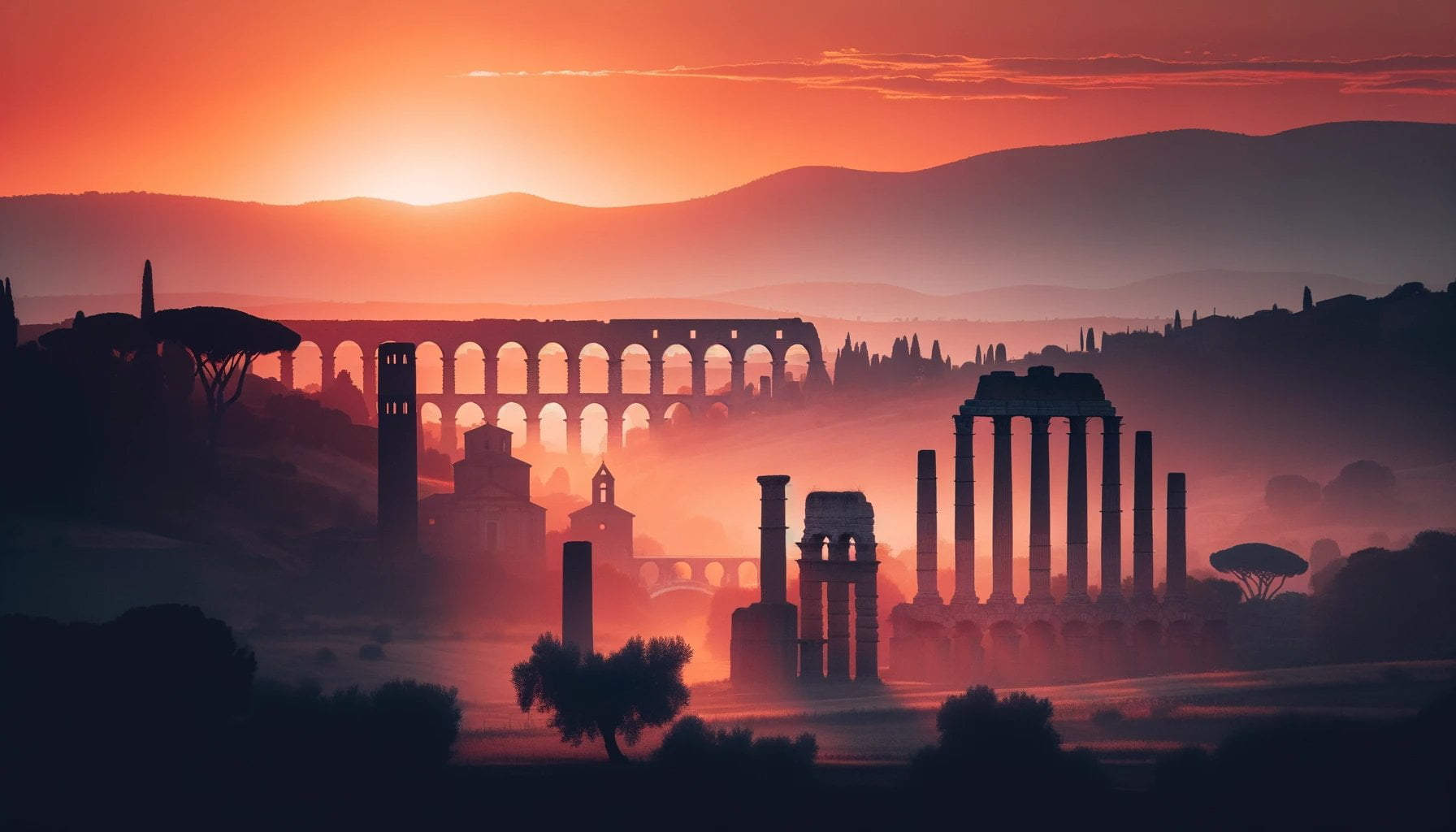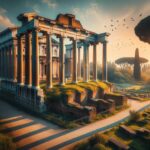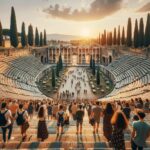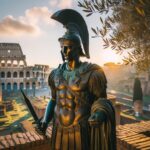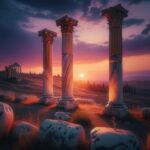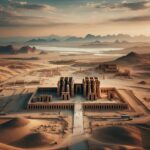Welcome to “Unveiling the Splendor: Ancient Roman Monuments”, where we embark on an enthralling journey through the captivating world of ancient Roman architecture and its magnificent monuments. Immerse yourself in the rich tapestry of history as we explore the distinctive characteristics, cultural significance, and enduring legacy of these awe-inspiring structures that have withstood the test of time. From the iconic colosseums and breathtaking amphitheaters to the majestic temples and grand residences, discover the remarkable ingenuity and artistic prowess of the ancient Romans that shaped the architectural landscape of Rome and beyond. Join us as we unveil the splendor of these extraordinary ancient Roman monuments and delve into the heart of a once-great empire.
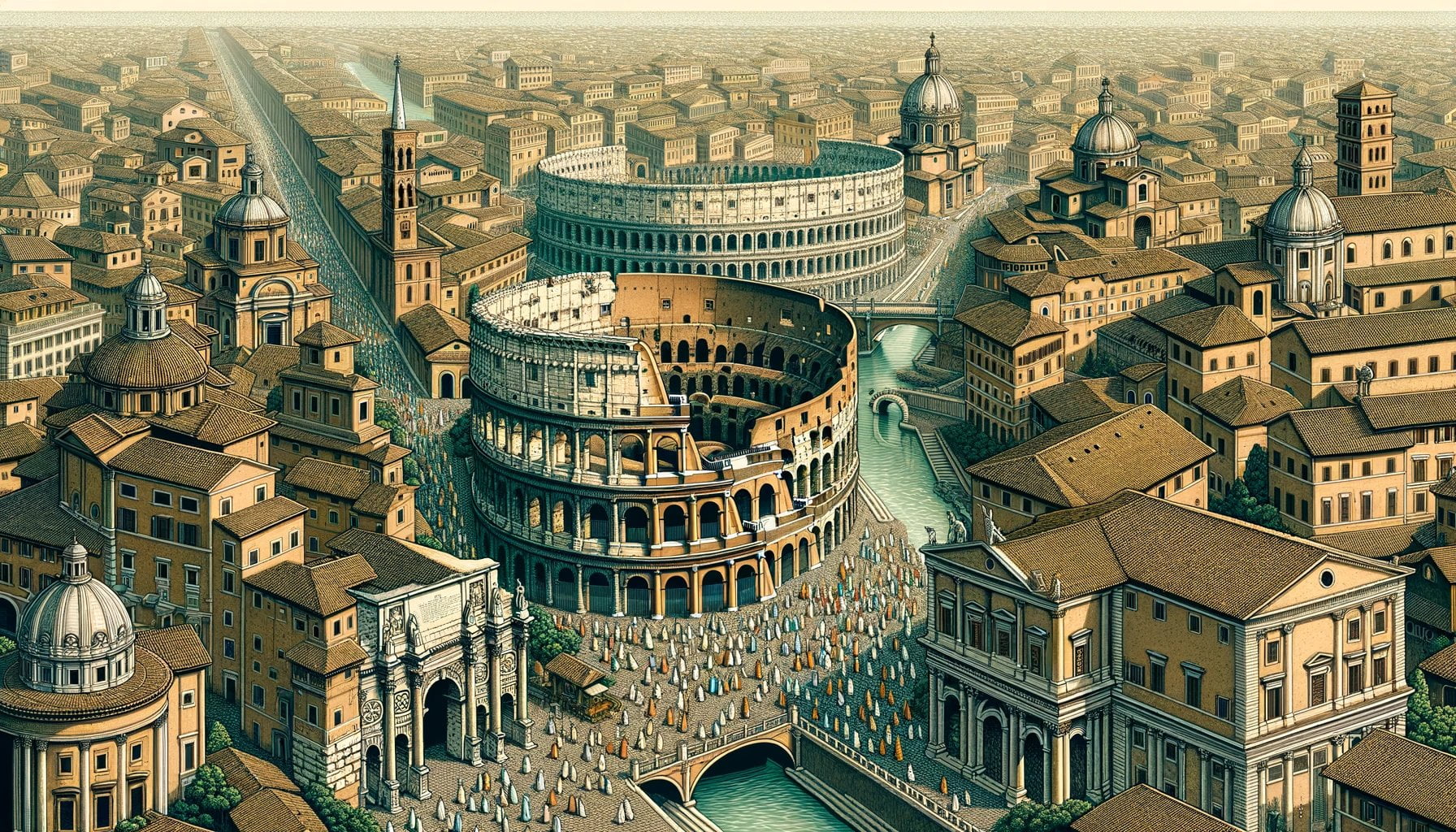
Key Takeaways: Ancient Roman Monuments
- The Colosseum: A colossal amphitheater commissioned by Emperor Vespasian and completed by his son Titus, the Colosseum stands as a testament to the grandeur and architectural brilliance of ancient Rome.
- The Pantheon: Built by Emperor Hadrian, the Pantheon’s magnificent dome and circular opening, known as the oculus, have influenced architectural designs throughout history.
- The Roman Forum: Once the heart of political and social life in ancient Rome, the Roman Forum served as a center for religious, political, and commercial activities.
- The Baths of Caracalla: These luxurious public baths provided not only hygiene facilities but also spaces for socialization and relaxation, featuring grand architecture and a variety of amenities.
- The Arch of Titus: Constructed to commemorate Emperor Titus’s military victories, the Arch of Titus serves as a powerful reminder of the military prowess and conquests of the Roman Empire.
Conclusion: Ancient Roman monuments, such as the Colosseum, Pantheon, Roman Forum, Baths of Caracalla, and Arch of Titus, provide insights into the rich history, culture, and achievements of the Roman Empire, leaving an indelible mark on the world with their stunning architecture.
Ancient Roman Monuments: A Journey Through History
The Colosseum: A Testament to Grandeur
The Colosseum, also known as the Flavian Amphitheater, stands as one of the most recognizable symbols of ancient Rome. This colossal structure, commissioned by Emperor Vespasian and completed by his son Titus, showcases the grandeur and architectural brilliance of the Roman Empire. With a seating capacity of up to 50,000 spectators, the Colosseum hosted gladiatorial contests and public spectacles that demonstrated the power and wealth of Rome. Today, it remains an awe-inspiring testament to the opulence and magnificence of ancient Roman culture.
The Pantheon: Where Architecture Meets Divinity
Built by Emperor Hadrian, the Pantheon is a temple dedicated to the gods of ancient Rome. It is renowned for its architectural masterpiece, especially its magnificent dome. This dome, considered an engineering marvel, features a large oculus that allows sunlight to filter into the temple, creating a breathtaking spectacle. The Pantheon’s innovative design has influenced architectural structures throughout history and continues to inspire architects today. It is a captivating blend of divinity and architectural excellence.
The Roman Forum: A Window into Ancient Politics
The Roman Forum served as the heart of political and social life in ancient Rome. This expansive plaza, encompassed by government buildings and temples, witnessed centuries of religious, political, and commercial activities. The Forum of Augustus, the Forum of Caesar, the Forum of Nerva, and the Forum of Peace are some of the major structures within the Roman Forum. These forums provided spaces for public gatherings, political discussions, and displays of imperial power. Exploring the Roman Forum offers a fascinating glimpse into the political landscape of ancient Rome.
The Baths of Caracalla: Luxurious Relaxation
The Baths of Caracalla, constructed by Emperor Caracalla, were not just places for hygiene but also centers of leisure and socialization. These baths boasted remarkable architecture, including expansive halls, exercise rooms, libraries, and even a stadium for athletics. Accommodating up to 1,600 bathers at a time, the Baths of Caracalla offered a variety of amenities such as hot and cold pools, saunas, and gardens. They exemplified the Roman concept of luxurious relaxation and represented the grandeur and indulgence of the Roman Empire.
The Arch of Titus: Commemorating Triumph
The Arch of Titus, located in the Roman Forum, stands as a commemoration of Emperor Titus’ military victories during the First Jewish-Roman War. This triumphal arch features intricate reliefs depicting scenes from the war, including the triumphal procession and the spoils of Jerusalem. It serves as a powerful reminder of the military prowess and conquests of the Roman Empire. The Arch of Titus is a testament to the historical significance of ancient Rome and its lasting impact on the world.
Ancient Roman monuments are not merely relics of the past; they are living testaments to the grandeur, cultural achievements, and architectural prowess of the Roman Empire. These majestic structures continue to amaze and inspire visitors, allowing them to step back in time and experience the opulence and magnificence of ancient Rome. By exploring ancient Roman monuments, we can gain a deeper understanding of the rich history, culture, and achievements of one of the greatest civilizations in history.
If you’re fascinated by the architectural marvels of the past, you won’t want to miss exploring these ancient Roman pillars. Check out our collection of these beautiful structures here.
Step into the arena of history with a glimpse into the world of gladiators by discovering their remarkable ancient Roman gladiator armor. Uncover the secrets of their fierce battles by clicking here.
Experience the strength and artistry of the Roman military through their remarkable ancient Roman shields. Discover the variety and intricate designs of these defensive marvels by clicking here.
Delve into the fascinating realm of ancient Roman philosophy and gain insights into the intellectual achievements that shaped Western thought. Expand your knowledge by exploring this rich cultural heritage through our link here.
Ancient Roman Monuments in Rome
Ancient Roman monuments in Rome stand as magnificent testaments to the historic grandeur and architectural brilliance of the Roman Empire. These awe-inspiring structures offer a glimpse into the opulence and splendor of ancient Rome, showcasing a rich tapestry of cultural significance and historical context. In this article, we will delve into the captivating world of ancient Roman monuments, exploring their architectural styles, cultural importance, and enduring legacy.
Unveiling the Roman Empire’s Marvels
The ancient city of Rome is adorned with a plethora of remarkable Roman monuments that have withstood the test of time. From grand amphitheaters to magnificent temples, these awe-inspiring structures bear witness to the power and creativity of the Roman Empire. Let’s embark on a virtual journey through some of the most significant ancient Roman monuments in Rome.
The Colosseum: Where Spectacles and Grandeur Collide
[ancient roman monuments in rome]
Undoubtedly, the Colosseum stands tall as a symbol of the architectural brilliance of ancient Rome. This grand amphitheater, also known as the Flavian Amphitheater, was a testament to the Romans’ engineering prowess and their love for spectacles. Hosting gladiatorial contests, animal hunts, and mock sea battles, the Colosseum was a center of entertainment and a display of imperial might.
The Pantheon: A Dome of Heavenly Elegance
[ancient roman monuments in rome]
Step into the Pantheon, and you’ll find yourself in the presence of architectural magnificence. This ancient temple boasts a striking dome, ingeniously designed to allow sunlight to filter through an oculus at its center. The Pantheon’s influence can be traced throughout history, inspiring countless architectural structures. Even after centuries, this Roman monument remains in use and continues to captivate visitors with its breathtaking beauty.
The Roman Forum: A Window into Ancient Rome’s Political Hub
[ancient roman monuments in rome]
Immerse yourself in the heart of ancient Rome by exploring the Roman Forum. This sprawling complex served as the center of political and social life in ancient Rome, with its numerous structures dedicated to public gatherings, ceremonies, and displays of power. From the Temple of Saturn to the Senate House, the Roman Forum provides a glimpse into the political and social fabric of the Roman Empire.
Key Takeaways:
- Ancient Roman monuments in Rome embody the architectural brilliance and cultural significance of the Roman Empire.
- The Colosseum stands as a grand amphitheater that hosted spectacles and showcased imperial power.
- The Pantheon’s dome exemplifies heavenly elegance and has influenced architectural structures throughout history.
- The Roman Forum served as the vibrant political and social hub of ancient Rome, reflecting its power and governance.
Sources:
– Wikipedia: List of ancient monuments in Rome
– Touropia: 52 Ancient Roman Monuments (with Map)
Ancient Roman Buildings
The opulence and grandeur of Ancient Roman monuments continue to captivate enthusiasts and history buffs alike. From the iconic Colosseum to the awe-inspiring Pantheon, these architectural marvels are testaments to the ingenuity and creativity of the Roman Empire. In this article, we will delve into the splendor of Ancient Roman buildings, exploring their architectural styles, cultural significance, and historical context.
Roman Architecture: A Blend of Influences
Ancient Roman architecture emerged as a unique blend of classical Greek styles and distinctive Roman features. While incorporating elements from ancient Greece, such as columns and proportions, Roman buildings showcased their own characteristics, reflecting the cultural and political climate of the Roman Empire.
The Roman Colosseum, a structure synonymous with Ancient Rome, stands as a testament to the grandeur and engineering prowess of the era. This iconic amphitheater, designed for gladiatorial contests and public spectacles, served as a gathering place for the Roman populace. It remains an awe-inspiring symbol of the empire’s power and entertainment culture.
The Pantheon: A Marvelous Temple
Another remarkable Roman building is the Pantheon, a temple built in 126 AD. The Pantheon’s magnificent dome, an architectural wonder, has influenced structures throughout history. With its oculus, a central opening that allows sunlight to filter in, the Pantheon creates a celestial ambiance. It stands as a testament to the Roman Empire’s dedication to religious worship and architectural innovation.
Beyond Rome: Magnificent Roman Monuments
While Rome is known for its abundance of Ancient Roman buildings, the architectural splendor of the empire extended far beyond the city’s borders. The amphitheater in Nimes, once known as Nemausus, is a fascinating example. This well-preserved Roman monument showcases the empire’s architectural prowess in regions beyond Italy.
Mausoleums also hold a significant place in Roman architecture. One famous example is the tomb of Caecilia Metella, a striking cylindrical structure that exemplifies the grandeur and commemorative nature of Roman mausoleums. These tombs served as tributes to notable individuals and their families, reflecting the importance placed on ancestry and legacy in Roman culture.
The Enduring Legacy
Ancient Roman buildings, constructed using innovative materials like Roman concrete, have withstood the test of time. The longevity and preservation of many structures were due in part to the durability of these materials.
Additionally, Roman architecture has had a profound influence on subsequent architectural styles. Elements such as arches, vaults, and domes found in Ancient Roman buildings can be seen in structures across the globe, demonstrating the lasting impact of Roman engineering and design.
Key Takeaways:
- Ancient Roman architecture blended Greek influences with distinctive Roman features.
- The Colosseum, an iconic amphitheater, showcases the grandeur and engineering prowess of the Roman Empire.
- The Pantheon’s dome and oculus have influenced architectural structures throughout history.
- Roman architecture extended beyond Rome, with notable monuments found in various regions.
- Mausoleums, like the tomb of Caecilia Metella, highlight the commemorative nature of Roman culture.
- The longevity and preservation of Roman buildings can be attributed to the use of innovative materials like Roman concrete.
- Ancient Roman architecture has had a lasting influence on subsequent architectural styles.
Sources:
– Touropia: Ancient Roman Monuments (with Map)
– Wikipedia: Ancient Roman architecture
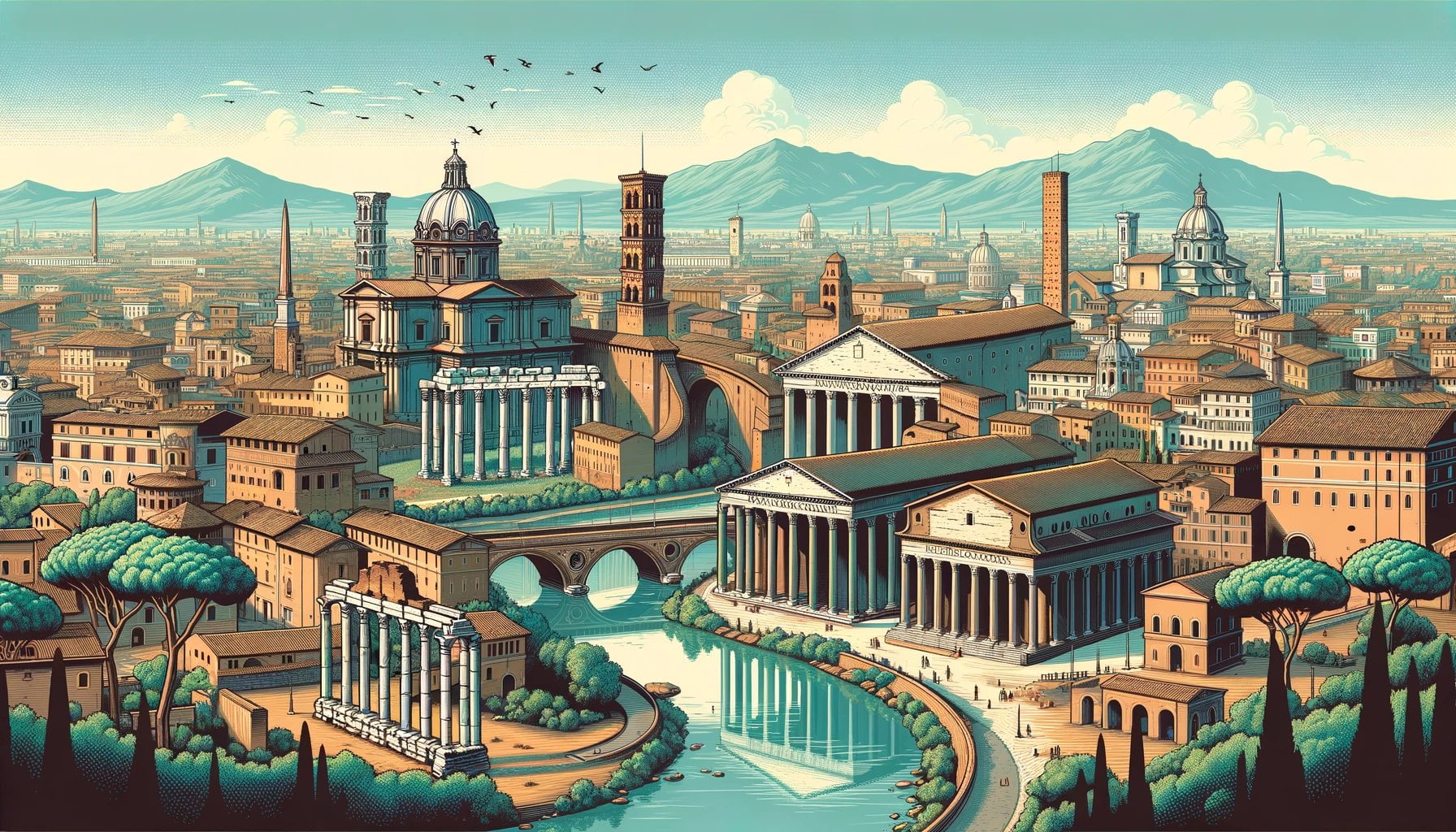
FAQ
Q1: What are some characteristics of ancient Roman architecture?
A1: Ancient Roman architecture is known for its use of classical Greek architectural elements such as columns, arches, and domes, as well as its incorporation of new materials like Roman concrete. It often featured grandiose designs, monumental scale, and intricate ornamentation.
Q2: What are some famous ancient Roman monuments in Rome?
A2: Rome is home to numerous famous ancient Roman monuments, including the Colosseum, the Pantheon, the Roman Forum, the Baths of Caracalla, and the Arch of Titus.
Q3: What are some ancient Roman buildings in Rome?
A3: Some notable ancient Roman buildings in Rome include the Circus Maximus, the Porticus Aemilia, the Theatre of Pompey, and the Mausoleum of Augustus.
Q4: How did Roman architecture influence later architectural styles?
A4: Roman architecture had a significant influence on later architectural styles, with its use of arches, vaults, and domes serving as the foundation for Byzantine, Gothic, and Renaissance architecture. The principles of Roman architecture can still be seen in buildings around the world today.
Q5: What is the significance of ancient Roman monuments?
A5: Ancient Roman monuments hold great historical and cultural significance. They reflect the grandeur and power of the Roman Empire and provide insight into the architectural achievements and societal values of the time. These monuments also serve as reminders of Rome’s enduring legacy and continue to inspire awe and admiration.
- China II Review: Delicious Food & Speedy Service - April 17, 2025
- Understand Virginia’s Flag: History & Debate - April 17, 2025
- Explore Long Island’s Map: Unique Regions & Insights - April 17, 2025
